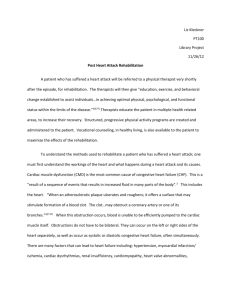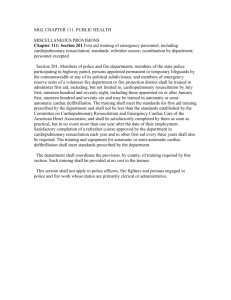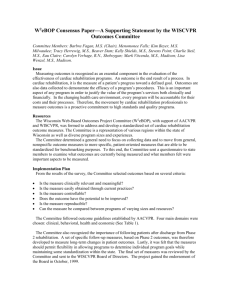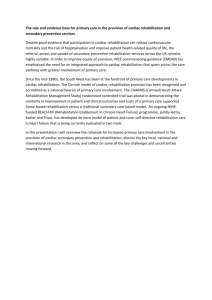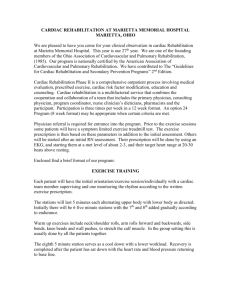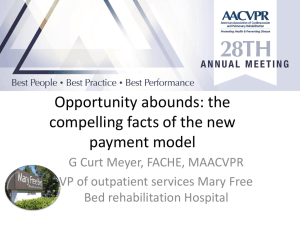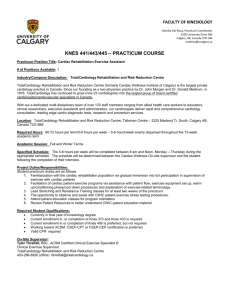Fundamental Shift in Cardiopulmonary Rehabilitation Ignites
advertisement
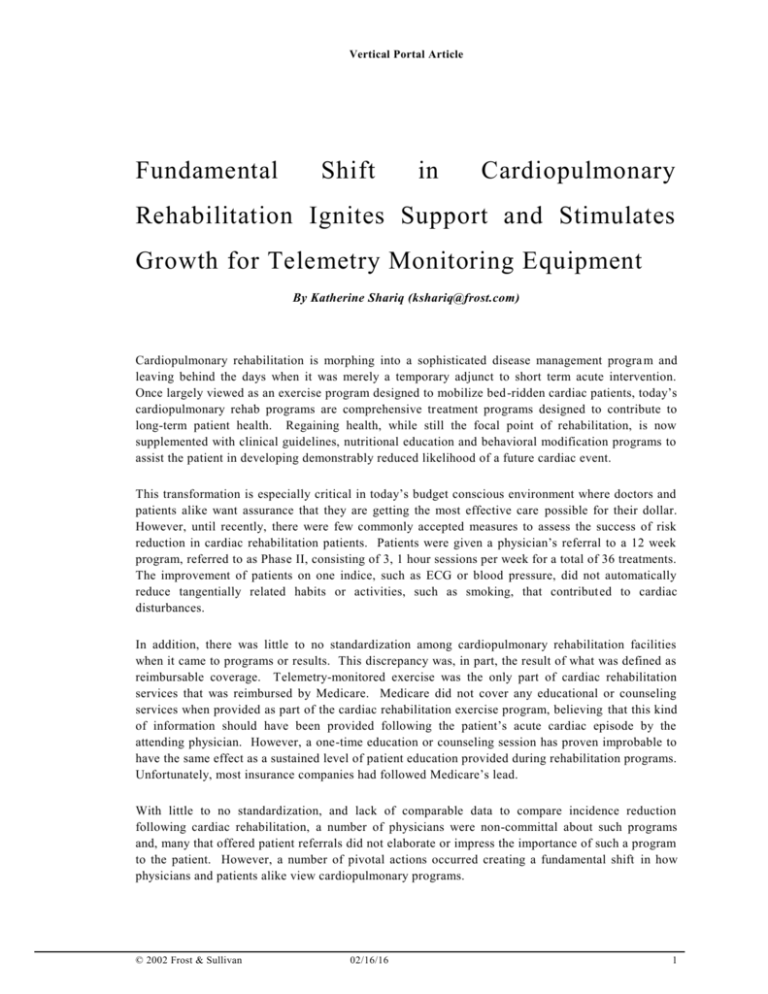
Vertical Portal Article Fundamental Shift in Cardiopulmonary Rehabilitation Ignites Support and Stimulates Growth for Telemetry Monitoring Equipment By Katherine Shariq (kshariq@frost.com) Cardiopulmonary rehabilitation is morphing into a sophisticated disease management progra m and leaving behind the days when it was merely a temporary adjunct to short term acute intervention. Once largely viewed as an exercise program designed to mobilize bed -ridden cardiac patients, today’s cardiopulmonary rehab programs are comprehensive treatment programs designed to contribute to long-term patient health. Regaining health, while still the focal point of rehabilitation, is now supplemented with clinical guidelines, nutritional education and behavioral modification programs to assist the patient in developing demonstrably reduced likelihood of a future cardiac event. This transformation is especially critical in today’s budget conscious environment where doctors and patients alike want assurance that they are getting the most effective care possible for their dollar. However, until recently, there were few commonly accepted measures to assess the success of risk reduction in cardiac rehabilitation patients. Patients were given a physician’s referral to a 12 week program, referred to as Phase II, consisting of 3, 1 hour sessions per week for a total of 36 treatments. The improvement of patients on one indice, such as ECG or blood pressure, did not automatically reduce tangentially related habits or activities, such as smoking, that contribut ed to cardiac disturbances. In addition, there was little to no standardization among cardiopulmonary rehabilitation facilities when it came to programs or results. This discrepancy was, in part, the result of what was defined as reimbursable coverage. Telemetry-monitored exercise was the only part of cardiac rehabilitation services that was reimbursed by Medicare. Medicare did not cover any educational or counseling services when provided as part of the cardiac rehabilitation exercise program, believing that this kind of information should have been provided following the patient’s acute cardiac episode by the attending physician. However, a one-time education or counseling session has proven improbable to have the same effect as a sustained level of patient education provided during rehabilitation programs. Unfortunately, most insurance companies had followed Medicare’s lead. With little to no standardization, and lack of comparable data to compare incidence reduction following cardiac rehabilitation, a number of physicians were non-committal about such programs and, many that offered patient referrals did not elaborate or impress the importance of such a program to the patient. However, a number of pivotal actions occurred creating a fundamental shift in how physicians and patients alike view cardiopulmonary programs. © 2002 Frost & Sullivan 02/16/16 1 Vertical Portal Article Shift in View of Cardiopulmonary Programs as Multiple Factors Coverge The convergence of physicians, patients and the healthcare industry away from acute intervention and towards treatment, maintenance and prevention measures are coinciding with the ability of the cardiac rehabilitation professional to measure and discuss the economic and social value that rehabilitation plays in the life extension of the patient and the translation of tha t to reduced patient load, quicker recovery time and less drain on the healthcare budget. With the number hospitals continuing to decline, following the institution of managed care and reimbursement cuts, and the U.S. population continuing to increase, the re has been a shift away from lengthy hospitalizations. Medical advances in medications, treatments and rehabilitation programs made follow-up patient recovery efforts easier and more manageable, enabling patients to leave the hospital sooner and continue treatment on an outpatient basis. Patients, many with internet access, are also looking at health care differently. They are becoming much more proactive about their medical care and subscribe to the doctor as more of a facilitator toward wellness, rath er than the older model of “patient as treatment recipient”. In addition, the movement away from time-based reimbursement and toward performace-based reimbursement had a startling effect on the cardiopulmonary industry. National certification of all cardiopulmonary programs began in earnest in 1999. Around that same time, state run cardiopulmonary associations began the process of trying to standardize cardiopulmonary patient risk analysis. Two leading program accreditation leaders, the Joint Commission on Accreditation of Healthcare Organizations and the Accreditation by the American Association of Cardiovascular and Pulmonary Rehabilitiation (AACVPR), require that cardiopulmonary programs engage in continous quality improvement activities. Industry Lead ers Take Lead in Standardizing and Benchmarking Outcomes In support of continuous quality improvement programs, a number of industry leaders took the lead in standardizing the type of outcomes to be measured, on a patient and facility basis, thus providing a means for industry participants to benchmark their results against state and national measurements. In the late 1990s, a forward thinking software development company, Orion Software Development, created an outcomes template (outcomes refer to the pre- and post-measurement of vital signs and risk indications) and data management software package that enabled any facility to analyse and record patient data on a standardized basis. Through its Orion Outcomes program, and in partnership with the Indiana Society of Cardiovascular and Pulmonary Rehabilitation (ISCVPR), Orion Software Development supplies the database management and analysis capability for a national database of clinical outcomes in the cardiopulmonary rehabilitation industry. Outcomes are increasingly being seen as a means to promote a rehabilitation facility’s reputation. Cardiac rehabilitation telemetry monitoring equipment providers such as Quinton Cardiology, ScottCare and Life Sensing Instruments have Orion Outcomes (Chart 1) embedded i nto their database management systems enabling the trainers to quickly and easily submit outcomes reports to the rehab © 2002 Frost & Sullivan 02/16/16 2 Vertical Portal Article outcomes national database. Facilities operating older equipment are also able to purchase the Orion Outcomes software independently to manage outcomes data collection and analysis. This third party run, national database provides an independent analysis comparing treatment results and provides state and national benchmark data to each participating facility. Chart 1 Chart 2 illustrates an abbreviated external comparison of outcomes chart that a participating cardiopulmonary facility would receive, providing a summary of the facilities outcomes data with the comparative state and national measures. The low, mean and high test results are provided at the state and national level. In this case, the facility or program had a mean clinical measurement of patient’s walking 197 feet during the 6 minute distance walk. The state mean however showed patients walking almost 73% more during the same test. Thus providing the facility with an independent measure of its ability to provide effective therapy. © 2002 Frost & Sullivan 02/16/16 3 Vertical Portal Article Chart 2 Source: Orion Software Development Nationally recognized leaders are able to offer a complete circle of care, beginning with prevention, treatment and recovery. As physicians become more aware of the higher recovery and long term success rates of cardiac patients undergoing Phase II training, as determined by the national database of rehab outcomes, demand for such services will increase and boost telemetry usage. As post-procedure outcome reporting increases, and physicians begin to tie cardiac recover y to successfully prescribed Phase II treatments, demand for services will increase and cardiac rehab facilities will be better positioned to request equipment. Patient ECG results and success rates will also be seen as a necessary metric to capture, as a way to generate more revenue by promoting a center’s recovery rating to the public. Although not yet the case, reimbursement in the future may eventually be based on a facility’s metrics of patient outcomes. For further information: http://www.orionoutcomes.com © 2002 Frost & Sullivan 02/16/16 4
